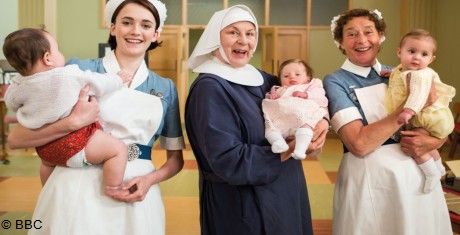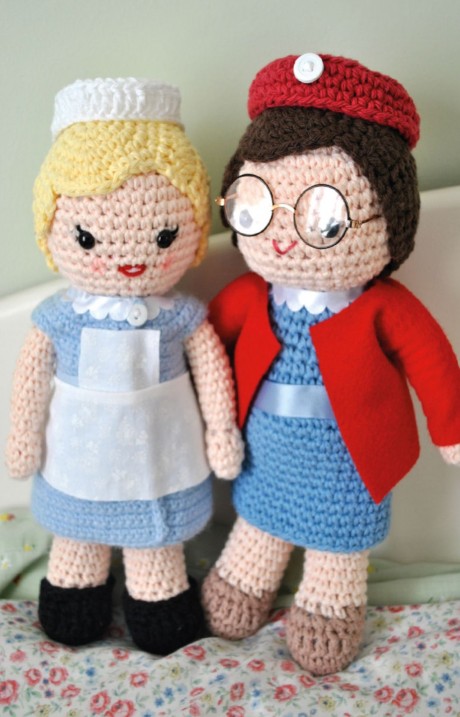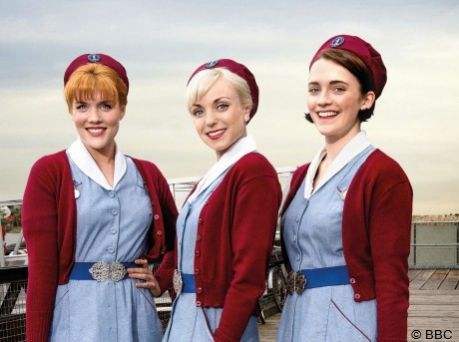Celebrate the knitted style of Call The Midwife
Can’t get enough of the knitters of Nonnatus House? Our favourite show is in its fifth year and we celebrate its style
We’re bubbling over with excitement here at LK. The reason? Series six of Call the Midwife starts on the 22nd January! The show’s enduring appeal – essentially a Party Political Broadcast on behalf of darling lacework sweaters and heart-melting pram sets – could, of course, be down to the excellent storylines, top rate acting and flawless script. Or it could be due to the quite fabulous knits. The jury’s out.
Okay, so Sister Monica Joan nearly broke the internet when she appeared to be knitting what was clearly a crocheted granny square, unleashing the wrath of many an eagle-eyed viewer, but what’s a little slip between friends? “Even though the whole knitting/granny square debacle was a fiasco, I really liked that story line,” says Seattle-based blogger Allison Griffiths. “There is something that really resonates with me, and probably most knitters, about getting together with people you care about to work together on a large project.”
Community spirit is certainly a real forte for the show, which was based on the experiences of writer Jennifer Worth’s career as a midwife in the 1950s and 60s. “I love seeing all the knitted sweaters, layette sets and bootees,” says Allison, whose On The Needles blog pays homage to the endless procession of great designs. “The 50s and 60s were an amazing time for knitting – all that angora! The show gives us a way to see it all. The twinsets, cardigans and fitted sweaters on the nurses are fantastic, as well as the elaborate, personalised knitwear for the babies. When I was a kid, I loved looking at my grandma’s old Workbasket magazines from the era, and watching this show is a lot like getting a front row to the women who originally bought those magazines.”

Fitting tribute
In 2013 Canadian amigurumi fanatic Amy Kember spotted a knitted doll of lead character Jenny Lee on the show’s official Facebook page, and was inspired to design a crochet Chummy. With the free pattern shared well beyond her original blog, Amy’s Gurumis, Crochet Chummy went viral, and encouraged Amy to tackle the rest of the cast. “The most surreal experience I had was when The One Show revealed photos of my Trixie doll during an interview with Helen George (the actress, and real-life knitting fan – who plays the series’ longest-standing main character). The most rewarding has been the Royal College of Midwives using my pattern for their exhibition of knitted and crocheted midwives.”

Amy Kember’s crocheted Trixie and Chummy
It’s easy to imagine a happy bank of handknitters working up garments for the show but alas, the reality is a little less romantic. “We hire the bulk of the costumes, including knitwear, from costumiers,” says the show’s costume designer Maggie Chappelhow. “We do buy some from vintage shops and are always thrilled if we find baby knitwear in vintage shops because we need lots of it. It was such a common tradition in this period.”
It’s showtime!
So what treasures can we expect in series six, which airs in the next few weeks and comes hot on the heels of a Christmas special set in South Africa? “We have used some really nice chunky-knit cardigans and, of course, our midwives still wear their hand-knitted cardigans,” says Maggie. “We’ve used lots of greens, yellows, blues and corals as the accent colours in our knitwear with neutral colours accompanying them. I use the stronger colours to bring out the colour in a patterned dress or make something richer or more jewel-like, especially on Barbara and Trixie. As the 1960s progressed there was more lurex and we’ve reflected that in the show. We still use Fair Isles on certain guest characters, as well as a lot of men’s sleeveless jumpers and zipped cardigans to evoke the era.”

Recreate the exact lace sweater worn by the show’s Jenny Lee with the Susan Crawford’s Ladys Evening Jumper Kit in Canary (£45, susancrawfordvintage.com)
If your knitting notebook is poised to receive this information, you may want to make a few more notes. “You can’t make a 50s design in an acrylic or modern synthetic yarn,” says Sue West who oversees a treasure trove of vintage patterns at her online shop, The Vintage Knitting Lady. “It has to be knitted in natural fibres so it’ll expand and contract. Those fitted waists and flicked collars of the era just don’t work in acrylic because you need a yarn that springs back. In the 60s new yarns such as nylon and acrylic came in and they were easier to care for and cheaper to produce. In the 50s 3ply was popular but going into the 60s things moved on to 4ply and double knitting. That made a big difference to garments because you can’t do a fine, lacy mist design in DK; you need a finer yarn to get the definition.”
Beware that patterns will have deceptive instructions, too. “The vintage patterns I’ve tried have been fairly straightforward, but seem to require a bit of instinct,” says Allison Griffiths. “When I write a pattern for a publication I make sure to write every stitch the knitter is supposed to make. When I look at a pattern from the 50s or earlier often there will be instructions such as ‘make the top of the hat in the usual way’ or ‘continue until you have achieved the desired result’. I think designers assumed a greater depth of knowledge in their knitters than they tend to today.”
“The patterns were a guide, not a blueprint,” agrees Sue. “If you needed to cast on a few more stitches, then you did. If you knit in wool, or a yarn with a high percentage of wool, it’ll have stretch to it. Nearly all the wools these days are machine washable.” And, of course, the golden rule is to dry your knits naturally. After all, do you think Sister Julienne would be seen dead mucking around with a tumble drier?!
The first episode of the new series of Call The Midwide airs on BBC One at 8pm on Sunday 22nd January, or catch up on BBC iPlayer





_333_180_c1.png)

_Craftihive_Let_s_Knit_Website_Blog_-_7.9.25_HEADER_IMAGE-01__333_180_64_c1.jpg)

_333_180_64_c1.jpg)
 Baby
Baby
 Toys
Toys
 Garments
Garments
 Crochet
Crochet
 Homewares
Homewares
 Dolls
Dolls



Share